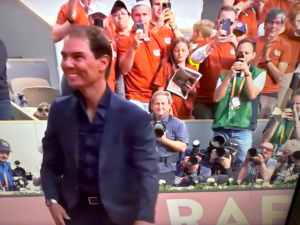Next Gen: Victoria Mboko
Victoria Mboko isn’t just winning matches—she’s changing how young players approach the game. At just 18, the Canadian rising star is handling her first Grand Slam like a seasoned vet, ripping backhands past top players and treating major moments like business as usual.
After bulldozing through qualifying and knocking out a former Wimbledon quarterfinalist in her French Open debut, Mboko followed it up by taking down Eva Lys in straight sets. That’s not luck. That’s a game—and a mindset—built to last.
Family First: The Mboko
The Mboko family isn’t just part of her support system—they’re the foundation of everything she’s doing right now. Her parents, Cyprien and Godée, made the leap from war-torn Congo to North America, enduring years of separation before settling in the Toronto area. Her father worked overnight shifts to get his kids to training. That’s not a detail—it’s a defining trait of this story.
Victoria is the youngest of four, all of whom played tennis. Her sister Gracia, now a private equity consultant, played at the University of Denver. Her brother Kevin is a coach. The expectations were high, but so was the support. At nine years old, Victoria stepped into a women’s tournament—just because there was an open spot. She lost 6-0, 6-0 to her sister, but walked off like the result should’ve been reversed.
Why Her Game Works
Lightning Feet, Locked-In Mind
Mboko’s footwork is sharp—prep steps, split steps, recovery, all on point. She’s not just fast, she’s balanced, which gives her time and freedom to strike. Movement wins on clay, and she’s already in the conversation with the best.
Mentally, she’s using classic sports psychology techniques—reframing pressure, staying in the present, even using “pretend it’s not a Slam” tactics to keep herself loose and aggressive.
Shot Variety and Smart Adjustments
Though she leans toward aggressive baseline play, Mboko’s also shown flashes of clay-court savvy—mixing in drop shots, slices, and some surprisingly disruptive forehand touch shots. That’s not instinct. That’s high-level tactical awareness.
Habits That Power Performance
Every day starts early: breakfast, warm-up, 30-minute hit, then time alone. These aren’t rituals for show—they’re identity-based habits, straight from the Atomic Habits playbook. She’s building repeatable success with systems, not superstition.
What Mboko Can Teach Every Competitive Player
Victoria Mboko isn’t just a next gen player —she’s a walking blueprint for how to do things right. Here’s what you should be learning from her playbook:
-
Play Big, Think Small
She treats major matches like just another day at the office. That’s not downplaying the moment—it’s owning it. Reframing pressure is a skill, and she’s mastering it early.
-
Let Your Feet Set the Tone
Her movement isn’t just quick—it’s efficient. Clean footwork keeps her balanced, in control, and ready to strike. Want consistency? Start with your balance.
-
Build Your Day Like You Build Your Game
From wake-up to match time, Mboko’s routine is dialed. No wasted energy, no surprises. It’s not superstition—it’s system. Want results? Lock in your process.
-
Train the Mind Like the Body
She doesn’t just hit balls—she works on staying present, brushing off mistakes, and resetting fast. That’s elite-level emotional control, and it wins matches.
-
Lean Into Your People
Her family keeps her grounded, not distracted. A strong circle isn’t hype—they’re your buffer from chaos. If your support crew isn’t helping you stay calm and sharp, re-evaluate.
Wrap
Mboko’s rise isn’t magic. It’s movement, mindset, and habits—executed with purpose, every single day.







